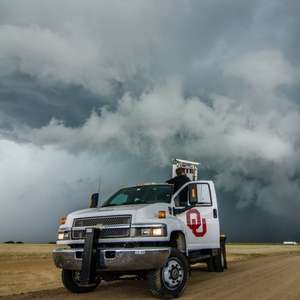Norman, Okla.—The University of Oklahoma Shared Mobile Atmospheric and Teaching radar team, led by Michael Biggerstaff, OU School of Meteorology, will deploy to the east coast today with the hurricane-tested SR2 C-band dual-polarimetric SMART radar and the National Oceanic and Atmospheric Administration’s National Severe Storm Laboratory mobile mesonet. The OU team with Sean Waugh, NSSL, will coordinate data collection with a Digital Hurricane Consortium consisting of researchers from multi-university, multi-agency and private-sector entities on location in the United States where Irma makes landfall.
“The group will focus on Irma’s extreme winds making the Irma deployment more difficult than what was experienced with Harvey. Irma is expected to be a stronger hurricane at landfall, which will require the team to deploy farther inland. The heavily wooded and developed east coast make finding suitable sites especially challenging,” said Biggerstaff.
The OU team of Biggerstaff, Gordon Carrie, OU researcher, and Addison Alford, OU doctoral student, with NSSL’s Waugh will join Dan Dawson, Purdue University; Kevin Knupp, University of Alabama-Huntsville; Forrest Masters, University of Florida; and John Schroeder, Texas Tech University, on the east coast. Dawson is bringing the OU and Purdue Portable Integrated Precipitation System to measure winds, temperature, pressure and humidity. The system also includes a Parsivel 2 laser disdrometer to measure the size of the rain drops.
The team hopes the combined radar and precipitation system measurements will provide insight into the evaporational cooling of rainfall in the outer bands of Irma that may impact the potential energy feeding the eyewall and, ultimately, the extreme wind within the storm. Irma radar imagery should be available at http://smartr.metr.ou.edu/irma/smart2.
For more information, contact Biggerstaff at 405.623.1769 or email drdoppler@ou.edu.



